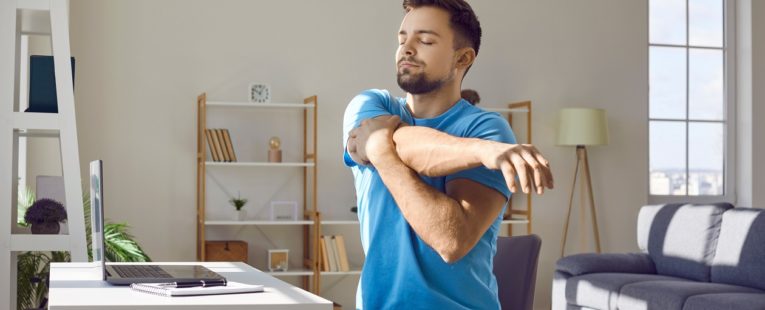In today’s world, prolonged periods of sitting at desks are common, whether at home or in the office. This can lead to poor posture, reduced circulation and muscle stiffness, potentially resulting in serious health issues like heart disease or diabetes.
The good news: You don’t have to hit the gym to counteract the effects of sitting.
Ginny Crook, occupational therapist at OSF HealthCare, explains how desk exercises or simple movements at or near your workstation can help you stay active, energized and healthy throughout the day.
Need help getting active?
Why desk exercises matter
Even short bursts of movement can significantly benefit your physical and mental well-being. When you exercise at your desk:
- You improve blood circulation, which reduces the risk of clots and decreases leg swelling
- You activate muscles that weaken from long periods of inactivity, helping prevent back and neck pain
- You boost your mood and energy, thanks to the endorphins released during movement
- You increase focus and productivity, as light activity improves oxygen flow to the brain
“Best of all, desk exercises can be done without special equipment and in just a few minutes,” Ginny said.
Easy desk exercises and stretches that don’t require equipment
Here are eight effective and discreet stretches you can incorporate into your daily routine. Hold each pose for 10 seconds:
- Side bends: Raise one arm straight up and bend to the opposite side. Repeat with the opposite side.
- Lumbar stretch: Place your hands on your hips and stretch backward from the waist.
- Chest opener: Intertwine your fingers behind your back and stretch your shoulders back while thrusting out your chest.
- Hamstring stretch: While using the desk for support, place one foot forward with your foot pointing up and gently squat down on the supporting leg, stretching the hamstring of the extended leg.
- Wrist extensions: Extend one arm, palm facing out with fingers pointing down and take your other hand and gently pull back on your fingers, stretching the bottom wrist muscles.
- Wrist flexions: Extend one arm, palm facing in with fingers pointing down and take your other hand and gently pull back on the back of your extended hand, stretching the top wrist muscles.
- Shoulder shrugs: With your body square, alternate raising your shoulders, reaching as high as you can.
- Figure 4 stretch: Cross one leg over the other with your ankle resting on top of the opposing knee while gently leaning forward, stretching the leg and lower back muscles.
“Don’t forget to alternate sides,” Ginny said. “You want to maintain a good balance between opposing muscles to avoid injury.”
Desk exercise options with exercise equipment
Keeping exercise equipment at your desk counters the negative effects of prolonged sitting. It engages muscles and promotes better circulation. Desk-friendly equipment can reduce fatigue, improve posture and support long-term wellness. Some options include:
- Under-desk bike pedal exercisers or mini ellipticals: Provide smooth under-desk pedaling to keep legs active, enhancing cardiovascular health and burning calories without distraction.
- Resistance bands: Great for strength training, posture correction and stretching. Lightweight and versatile for upper and lower body exercises.
- Balance chairs or stability balls: Engage core muscles and enhance posture. Encourages active sitting, reducing back pain and stiffness.
- Mini hand weights and grip strengtheners: Enable quick hand and arm workouts, building muscle tone and boosting metabolism.
- Aerobic step or walking pads: Enable short cardio bursts during breaks. Supports leg strength, balance and heart health.
- Standing desk: Reduces back pain, improves posture and boosts energy by encouraging more movement throughout the day.
“Since sitting for prolonged periods can lead to a range of negative health effects, following a desk workout plan or using an under-desk elliptical or walking pad is worth the investment, both in time and money,” Ginny said.
Tips to Make It a Habit
To make desk exercise part of your daily routine:
- Set reminders every 30–60 minutes to stand or move
- Combine movement with tasks, like walking during phone calls or stretching while reading emails
- Use a fitness tracker or app to monitor steps or movement goals
“Desk exercises are a fantastic and time-efficient way to counteract the effects of sitting, helping keep your body and mind sharp throughout the day. You don’t need a gym membership or fancy equipment – just a few minutes and a little consistency,” Ginny said. “By incorporating these easy movements into your daily work routine, you’ll feel better, think more clearly and move more freely, all while staying comfortably at your desk.”
To learn more about the dangers of a sedentary lifestyle or spending too much time sitting, talk to your primary care provider.
Last Updated: July 18, 2025
